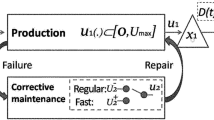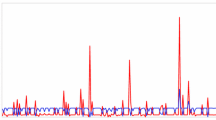Abstract
This paper considers a failure-prone manufacturing system with exponentially distributed operational times and constant repair times. Under the hedging-point policy, the steady-state probability density function of the buffer level is determined. The optimality of the hedging-point policy for this problem is proven, and analytical expressions for the computation of the optimal hedging point are determined. It is also shown that the optimal hedging point for the system with constant repair times provides a lower bound for the optimal hedging point for any other independent, identically distributed (iid) repair time sequence having the same mean. Using a queueing equivalence, an expression is derived for determining the optimal hedging point for any iid repair time sequence.
Similar content being viewed by others
References
Akella, R. and P.R. Kumar. (1986). “Optimal Control of Production Rate in a Failure Prone Manufacturing System.” IEEE Transactions on Automatic Control 31(2), 116–126.
Algoet, P. (1989). “Flow Balance Equations for the Steady-State Distribution of a Flexible Manufacturing System.” IEEE Transactions on Automatic Control 34(8), 917–921.
Bielecki, T. and P.R. Kumar. (1988). “Optimality of Zero-Inventory Policies for Unreliable Manufacturing Systems.” Operations Research 36, 532–541.
Boukas, E.K. and A. Haurie. (1990). “Manufacturing Flow Control and Preventive Maintenance: A Stochastic Control Approach.” IEEE Transactions on Automatic Control 35(9), 1024–1031.
Caramanis, M. and G. Liberopoulos. (1992). “Perturbation Analysis of Flexible Manufacturing System Flow Controllers.” Operations Research 40, 1107–1125.
Caramanis, M. and A. Sharifnia. (1991). “Near Optimal Manufacturing Flow Controller Design.” International Journal of Flexible Manufacturing Systems 3(3/4), 321–336.
Doshi, B.T. (1978). “Optimal Control of the Service Rate in an M/G/1 Queueing System.” Advances in Applied Probability 10, 682–701.
Gershwin, S., R. Akella, and Y. Choong. (1985). “Short Term Production Scheduling of an Automated Manufacturing Facility.” IBM Journal of Research & Development 29(4), 392–400.
Gershwin, S. (1994). Manufacturing Systems Engineering, Englewood Cliffs, NJ: Prentice Hall.
Glasserman, P. (1995). “Hedging-Point Production Control with Multiple Failure Modes.” IEEE Transactions on Automatic Control 40(4), 707–712.
Hu, J.Q., P. Vakili, and Y.G. Yu. (1994). “Optimality of Hedging Point Policies in the Production Control of Failure-Prone Manufacturing Systems.” IEEE Transactions on Automatic Control 39(9), 1875–1880.
Hu, J.Q. and D. Xiang. (1993). “The Queueing Equivalence to a Manufacturing System with Failures.” IEEE Transactions on Automatic Control 38(3), 499–502.
Hu, J.Q. and D. Xiang. (1995). “Optimal Control for Systems with Deterministic Production Cycles.” IEEE Transactions on Automatic Control 40(4), 782–786.
Kella, O. and W. Whitt. (1992). “A Storage Model with a Two-State Random Environment.” Operations Research 40, Suppl. 2, S257–S262.
Kimemia, J. and S. Gershwin. (1993). “An Algorithm for the Computer Control of Production in Flexible Manufacturing Systems.” IIE Transactions 15(4), 353–362.
Kleinrock, L. (1975). Queueing Systems, Vol. 1: Theory. New York: Wiley.
Krichagina, E.V., S.X.C. Lou, S.P. Sethi, and M.I. Taksar. (1995). “Diffusion Approximation for a Controlled Stochastic Manufacturing System with Average Cost Minimization.” Mathematics of Operations Research 20(4), 895–922.
Liberopoulos, G. and M. Caramanis. (1994). “Production Control of Manufacturing Systems with Production Rate-Dependent Failure Rates.” IEEE Transactions on Automatic Control 39(4), 889–895.
Perkins, J.R. and R. Srikant. (1997). “Scheduling Multiple Part-Types in an Unreliable Single Machine Manufacturing System.” IEEE Transactions on Automatic Control 42(3), 364–377.
Perkins, J.R. and R. Srikant. (1998). “Hedging Policies for Failure-Prone Manufacturing Systems: Optimality of JIT Policies and Bounds on Buffer Levels.” IEEE Transactions on Automatic Control 43(7), 953–957.
Perkins, J.R. and R. Srikant. (2001). “Failure-Prone Production Systems with Uncertain Demand.” IEEE Transactions on Automatic Control 46(3), 441–449.
Presman, E., S. Sethi, H. Zhang, and Q. Zhang. (1998). “Optimality of Zero-Inventory Policies for an Unreliable Manufacturing System Producing Two Part Types.” Dynamics of Continuous, Discrete and Impulsive Systems 4(4), 485–496.
Rishel, R. (1975). “Dynamic Programming and Minimum Principles for Systems with Jump Markov Disturbances.” SIAM Journal of Control 13(2), 338–371.
Sethi, S., W. Suo, M. Taksar, and H. Yan. (1998). “Optimal Production Planning in a Multi-Product Stochastic Manufacturing System with Long-Run Average Cost.” Discrete Event Dynamic Systems: Theory and Applications 8(1), 37–54.
Sharifnia, A. (1988). “Production Control of a Manufacturing System with Multiple Machine States.” IEEE Transactions on Automatic Control 33(7), 600–626.
Srivatsan, N. and Y. Dallery. (1998). “Partial Characterization of Optimal Hedging Point Policies in Unreliable Two-Part-Type Manufacturing Systems.” Operations Research 46(1), 36–45.
Stoyan, D. (1983). Comparison Methods for Queues and other Stochastic Models. New York: Wiley.
Subramanian, V. and R. Srikant. (2000). “Statistical Multiplexing with Priorities: Tail Probabilities of Queue Lengths and Waiting Times.” Queueing Systems 34(1-4), 215–236.
Tan, B. (2001). “Production Control of a Pull System with Production and Demand Uncertainty.” Working paper, Graduate School of Business, Koç University.
Author information
Authors and Affiliations
Rights and permissions
About this article
Cite this article
Perkins, J.R. Optimal Control of Failure-Prone Manufacturing Systems with Constant Repair Times. Annals of Operations Research 125, 233–261 (2004). https://doi.org/10.1023/B:ANOR.0000011193.32585.a8
Issue Date:
DOI: https://doi.org/10.1023/B:ANOR.0000011193.32585.a8




